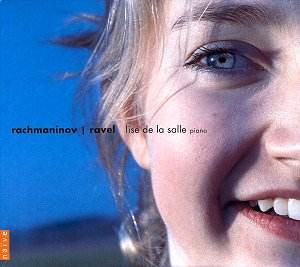Lise
de la Salle was born in 1988. To be accorded the privilege of
such a high-profile release on a major label is no small matter.
A glowing endorsement by Geneviève Joy-Dutilleux included
in the booklet raises expectations to a very high level. De la
Salle does not disappoint.
In
this world of prodigy and super-virtuoso, mention of the name
Rachmaninov sets alarm bells ringing. But any doubts harboured
were effectively banished by Op. 39 No. 1, the first track on
the disc. The stormy opening conveys all the requisite passion,
yet with an underlying clarity that eludes many more famous names.
Climaxes are notable for their contained ecstasy, and the whole
is underpinned by a superb recording.
De
la Salle seems intent on highlighting Ravelian tendencies in Rachmaninov,
an interesting take that yields rich rewards. Op. 39 No. 2 comes
across as freely improvisatory, yet with an attendant feeling
of gentle inevitability. Again, any inherent Frenchness of Op.
33 No. 6 is made clear. Starting à la Ravel, it soon becomes
Rachmaninov’s equivalent to Debussy’s Feux d’artifice.
The effect is not to demean or to de-individualise Rachmaninov,
however; more to introduce a particular slant to the musical text
which is further emphasised by de la Salle’s refusal to be over-indulgent
(Op. 33 No. 2 furnished a fine example of this).
On
home turf in Ravel, de la Salle is, if anything, even more impressive.
The delicate Sonatine is possessed of real tendresse
(even if inner voices can on occasion be just that touch too pronounced).
The toccata-touch de la Salle employs in the finale works perfectly
and her legato is equally fine. She almost achieves the ecstasy
of the close, but alas just misses.
The
five movements of Miroirs (Noctuelles; Oiseaux tristes;
Une barque sur l’Océan; Alborada del gracioso; La vallée
des cloches) also reveal an artist of no mean stature. De la Salle
captures the vaporous, elusive nature of ‘Noctuelles’ well and
is not afraid of the sad stasis of ‘Oiseaux tristes’, displaying
a maturity beyond her years. If the Spanish colours of ‘Alborada
del gracioso’ could have been painted in more vivid colours, it
is ‘Une barque sur l’Océan’ that provides the real highpoint
of this disc. Here all seems to slot naturally in place, so that
de la Salle’s delicacy can work naturally towards the climactic
points. Details and overview meet in a vision of loveliness. As
in the case of her Rachmaninov, indulgence is avoided, lending
more, not less, emotive weight to the cascades of sound.
This
is a superb disc that should be heard without delay. It is to
be hoped that Miss de la Salle will grace the UK with her presence
shortly. To learn more about this artist, her website is at http://lise.delasalle.online.fr/bioen.htm.
Colin
Clarke
